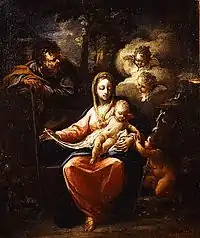Panagiotis Doxaras
Panagiotis Doxaras (Greek: Παναγιώτης Δοξαράς) (1662–1729) was a Greek painter who founded the Heptanese School of Greek art.[1]
Panagiotis Doxaras | |
|---|---|
| Born | 1662 |
| Died | 1729 |
| Occupation | painter |
Biography
He was born in Mani, although his family originated from Kalamata. In 1664, his family moved to Zante, where he was taught iconography by Leo Moscos. In 1694 he joined the Venetian army and fought against the Ottomans in Chios during the Morean War. In 1696 he left the Venetian army but continued recruiting fighters from Mani to fight for Venice against the Turks. The Venetians rewarded him with a knighthood and later (1721) by donating him several acres of land in Lefkas. From 1699 to 1704 he studied painting in Venice and from 1704 to 1715 he lived in Kalamata, which was then briefly under Venetian rule. The rest of his life he lived in the Ionian islands dividing his time between Lefkas, Corfu and Zante.[2] He died in 1729. He had five daughters and three sons.[3]
Work

.jpg.webp)
Doxaras' work signals the departure of Greek painting from the Byzantine iconography towards the Western European Renaissance art. He admired passionately the great Italian painters and in particular Leonardo da Vinci, whose book Art of painting (Trattato della pittura) he translated into Greek.[4]
In 1726 he wrote the famous, albeit controversial and much debated theoretical text On painting (Περί ζωγραφίας) in which he addressed the need for Greek art to depart from Byzantine art towards Western European art. The article was originally published after Doxaras' death in 1871. His article even today is the subject of much discussion in Greece.[5]
Despite Doxaras' religious subjects, he was the first painter that tried to depict realistically the faces of his figures and his paintings' religious scenes. Doxaras also introduced into Greek iconography the technique of oil painting, which replaced the old method of mixing pigments with egg yolk.[6] Having as a quide the works of Paolo Veronese, he painted the roof of Agios Spyridonas in Corfu, where he died. The images faded and later in the middle of the 19th century were replaced with newer ones painted by Nikolaos Aspiotis.[7] Doxaras was also the first painter that worked on portraiture. His most famous portrait was that of Count Graf von der Schulenburg, leader of the Venetian army and defendant of Corfu, which he signed as "Panagiotis Doxaras, Lacedaemonian Horseman, 1725, May 15th" (Hellenomnemon, p. 19) . Nikolaos Doxaras (1700/1706-1775), son of Panagiotis Doxaras continued the artistic legacy of his father.
See also
References
- Κουτσιλιέρη, Ανάργυρου: Ιστορία της Μάνης. Παπαδήμας, Αθήνα 1993
- Zakynthos-Zante- Peinture
- Panagiotis Doxaras, in Hellenomnemon, 1843, No.1, pp. 17-40. In Greek language
- Leonardo da Vinci Society Newsletter
- Δοξαράς, Παναγιώτης: Περί ζωγραφίας, εκδ. Σπ. Π. Λάμπρου, εν Αθήναις, 1871; Αθήνα (Εκάτη 1996)
- "Culture: Fine Arts". Archived from the original on 2008-12-29. Retrieved 2007-08-01.
- Λάμπρου, Σπ.: Συμπληρωματικαί ειδήσεις περί του ζωγράφου Παναγιώτου Δοξαρά Ν. *Ελληνομνήμων ή Σύμμικτα Ελληνικά, τ. 1, 1843